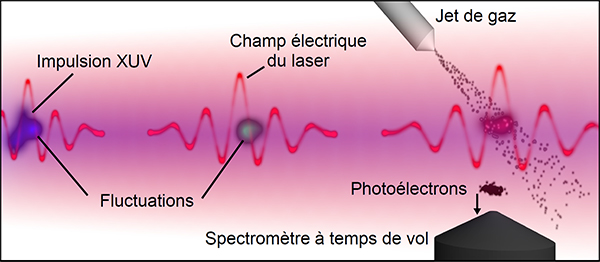In recent years, light sources have been central to research. Whether they are small enough to sit on a "table", or form large instruments of hundreds of meters, they help to push the scale limits of spatial-temporal studies. In this sense, recent free-electron lasers or other sources of high-order harmonic generation are the subject of intense development, while some of their characteristics are so far impossible to measure. A theoretical study by physicists at SOLEIL synchrotron and published in early March in the journal Nature Communications proposes a new method to accurately determine the temporal dimensions of the pulses delivered by these new light sources.
Light sources currently used in science deliver mostly invisible light, optimized within the ultraviolet (XUV) and X-ray ranges. In the case of free electron lasers (FELS) or sources of high-order harmonic generation (HHG), one speaks of ultrashort pulses to the femtosecond (1fs = 10^-15s) or even the attosecond (1as = 10^-18s) scale. Until now, in particular regarding FELS, it has been impossible to accurately measure the length of X pulses and scientists have had to rely on estimates. The SOLEIL synchrotron research group used several existing techniques to develop a method that makes this type of measurement possible. First, the idea was to use a well-known method known as "FROG" (Frequency Resolved Optical Gating) (see Figure 1). This method has long been used on lasers in the (near-) visible and XUV ranges on small experiments but had never been adapted to large instruments. The algorithms used to process the measurements were then adapted to incorporate a statistical approach inspired by recent advances in coherent diffraction imaging.

Figure 1: Schematic diagram analyzing the characteristics of XUV pulses. A standard laser is combined with the XUV pulse, all under a gas jet to create photoionization. The photoelectrons collected can then provide temporal information on the XUV pulse.
This method makes it possible to take into account the decoherence inherent in large light sources such as pulse fluctuations during measurement, or the limited resolution of the spectrometers used. In practice, the idea is to consider the data obtained as the result of the presence of numerous statistical states of the XUV pulse. Analysis is then used to determine if 99% of the pulses accumulated during the measurement are the same, or if several states coexist.
These temporal characteristics of XUV sources are far from being of interest only to theorists. Greater understanding of the pulses from these sources could be used to improve the treatment of data collected in experiments using this light. There is now a need to go beyond simulation and actually test the method on both HHG and FEL sources.
SOLEIL and free-electron lasers
SOLEIL is one of the LUNEX5 partners (free-electron Laser Using a New accelerator for the Exploitation of X-ray radiation of 5th generation), a new advanced free-electron Laser (FEL) project proposed by a consortium of eight French laboratories, which aims to study the production of intense and coherent ultra-short pulses (fs), in the soft X-ray region (20-4 nm).
